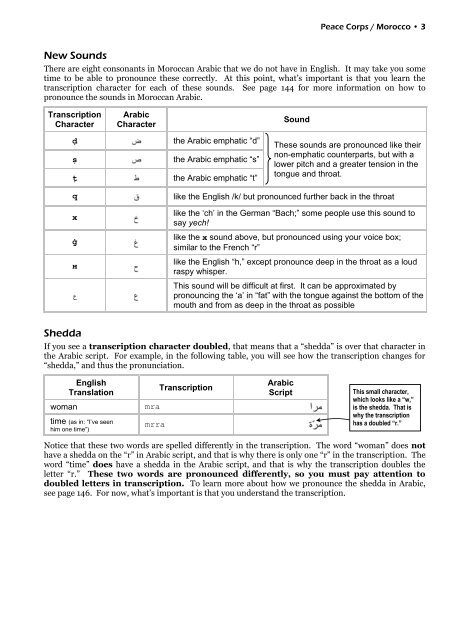Moroccan Arabic textbook 2011
Moroccan Arabic textbook 2011
Moroccan Arabic textbook 2011
Create successful ePaper yourself
Turn your PDF publications into a flip-book with our unique Google optimized e-Paper software.
Peace Corps / Morocco • 3<br />
New Sounds<br />
There are eight consonants in <strong>Moroccan</strong> <strong>Arabic</strong> that we do not have in English. It may take you some<br />
time to be able to pronounce these correctly. At this point, what‘s important is that you learn the<br />
transcription character for each of these sounds. See page 144 for more information on how to<br />
pronounce the sounds in <strong>Moroccan</strong> <strong>Arabic</strong>.<br />
Transcription<br />
Character<br />
<strong>Arabic</strong><br />
Character<br />
Sound<br />
ḍ<br />
ṣ<br />
ṭ<br />
the <strong>Arabic</strong> emphatic “d”<br />
the <strong>Arabic</strong> emphatic “s”<br />
the <strong>Arabic</strong> emphatic “t”<br />
These sounds are pronounced like their<br />
non-emphatic counterparts, but with a<br />
lower pitch and a greater tension in the<br />
tongue and throat.<br />
q<br />
x<br />
ġ<br />
н<br />
ع<br />
like the English /k/ but pronounced further back in the throat<br />
like the „ch‟ in the German “Bach;” some people use this sound to<br />
say yech!<br />
like the x sound above, but pronounced using your voice box;<br />
similar to the French “r”<br />
like the English “h,” except pronounce deep in the throat as a loud<br />
raspy whisper.<br />
This sound will be difficult at first. It can be approximated by<br />
pronouncing the „a‟ in “fat” with the tongue against the bottom of the<br />
mouth and from as deep in the throat as possible<br />
Shedda<br />
If you see a transcription character doubled, that means that a ―shedda‖ is over that character in<br />
the <strong>Arabic</strong> script. For example, in the following table, you will see how the transcription changes for<br />
―shedda,‖ and thus the pronunciation.<br />
woman<br />
English<br />
Translation<br />
time (as in: “I‟ve seen<br />
him one time”)<br />
mra<br />
mrra<br />
Transcription<br />
<strong>Arabic</strong><br />
Script<br />
This small character,<br />
which looks like a “w,”<br />
is the shedda. That is<br />
why the transcription<br />
has a doubled “r.”<br />
Notice that these two words are spelled differently in the transcription. The word ―woman‖ does not<br />
have a shedda on the ―r‖ in <strong>Arabic</strong> script, and that is why there is only one ―r‖ in the transcription. The<br />
word ―time‖ does have a shedda in the <strong>Arabic</strong> script, and that is why the transcription doubles the<br />
letter ―r.‖ These two words are pronounced differently, so you must pay attention to<br />
doubled letters in transcription. To learn more about how we pronounce the shedda in <strong>Arabic</strong>,<br />
see page 146. For now, what‘s important is that you understand the transcription.


